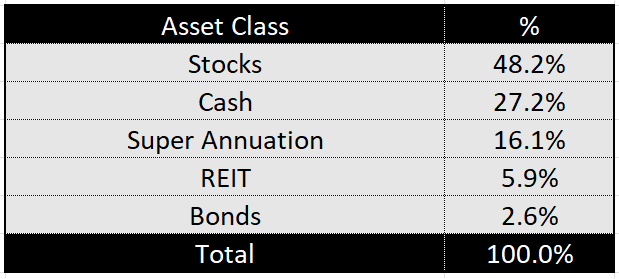Table of Contents
Introduction
As I was reviewing my investment portfolio and having a look at its performance, and suddenly, a good idea came to me.
Why not open my portfolio allocation with my readers and explain a little bit how and where I have been allocating my capital?
I am a little bit conservative when investing. I am not the kind of person that is looking to double my wealth via the stock market. My strategy is finding great companies at reasonable prices, buy and forget.
This strategy has been working well so far. Without further due, let me open my portfolio allocation.
My FIRE portfolio – Summary
The table and graphs below detail my current allocation split into different asset classes and geography.
Asset Classes
To facilitate your understanding, I divided my assets into five different classes:
- Stocks – Refers to the amount invested in stocks. I like the stock market and I believe it is a great investment tool. What attracts the most here are the wide variety of assets that you can invest in and liquidity offered by them.
- Cash – This is how much I have in my savings account. Cash is KING! I try to keep a considerable amount of liquidity in my portfolio. I don’t stick to a percentage, but having the equivalent of 12-24 months of my monthly expenses makes me sleep well – I also feel more confident to take more risks on board and make bold moves!
- SuperAnnuation (SuperAnnuation is the pension program here in Australia – you can see further details here) – Theoretically, I could set up a self-managed account and oversee this money more actively. But there is a lot of bureaucracy and I am not willing to have a lot of work to manage it. It sits with a SuperAnnuation fund that charges crazy fees and I should move to another one but I am lazy!
- REITs (Real Estate Investment Trusts) – According to Investopedia, “A real estate investment trust (REIT) is a company that owns, operates, or finances income-generating real estate.” I don’t invest in properties, but I do like REITs. They usually pay monthly or quarterly dividends and have great liquidity (good asset class if you are looking for constant dividends / passive income).
- Bonds – Bonds are debt instruments generally issued by a company or country/state/city (borrowers) in the market and bought by investors (lenders) that will receive a fixed income stream for a certain period of time, depending on the bonding characteristics. I have a minor allocation here.


From a geographical perspective, I allocate my portfolio according to the following breakdown.


I like invest across multiple categories and countries to ensure that there is a good level of diversification. For example, some emerging markets offer a good risk-return profile, and, even though they tend to be much more volatile than Australian market, they suit well my investment strategy (long-term view).
Detailed Stock Portfolio Analysis
As you can see, my allocation is heavily concentrated in stocks and cash. I consider myself as conservative investor and tend to stick to sectors with low volatility and great resilience.
The following table details the breakdown of my FIRE stock portfolio by sector.

Sector Analysis
- Financial Services – This includes banks, insurance companies, and financial services, such as ASX (The Australian Stock Exchange). The stocks in this sector tend to pay good dividends, which is a great tool for passive income. I like to invest in it because of its robustness and liquidity. The challenge here is finding stocks at a good price – in normal market conditions, they tend to be traded at a “premium”.
- Utilities – This includes energy providers, energy transmission companies, water/sewerage service providers, etc. Similarly to Financial Services, it is an extremely robust sector (i.e. regardless of an economic crisis, people will still need to drink water and rely on energy to live), which pays dividends regularly. Another great thing in this sector is those utility companies normally operate under a “monopoly” – utility providers usually do not have competitors (this depends on each jurisdiction). The challenge here is profit and operating margins – usually, we are talking about companies that operate in a regulated environment.
- Retail and Consumer Goods – I will put them together, even though they are slightly different. As with utilities, these sectors can be somehow resilient but are prone to crisis. I’ve a couple of stocks in retail, such as Coles (ASX:COL) in Australia. They tend to pay “ok” dividends, but are inserted in a highly competitive market (multiple players) and subject to consumption (If there is a crisis, their revenue can be highly impacted).
- Others – I will not assess the other sectors, given more than 85% of my FIRE portfolio. But as you can see, I have some investments in mining, communications, ETF (Exchange Traded Funds), healthcare, construction, infrastructure, and tech.
The takeaway from my portfolio review
I think the biggest takeaway from my portfolio is that I don’t invest to become rich. Instead, I am investing to protect my assets and generating some form of passive income. My goal is to slowly grow my portfolio and reinvest all the dividends that I receive.
I am extremely patient and don’t look to my stockbroker on a daily basis – in fact, this only makes you feel anxious about trading. As I told you in my “How do I invest” post, I am always seeking opportunities through value investing methodology and sometimes can wait for months until I buy a specific stock.
For example, a sector that I really want to expand my exposure is the tech sector. There are great companies over there, such as Facebook, Amazon, Apple, Netflix and Google (FAANG), but it is pricey at the moment.
Once in a while, a market crisis come, and lots of opportunities appear. That is the reason why I tend to have an expressive amount of cash sitting in my savings account – when the stock market decline, I am ready to shop!
What does your portfolio look like? Do you agree with my allocation? Leave a comment and let’s discuss.
Speak (write) soon!




